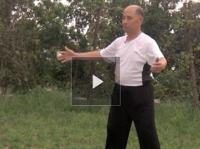Positive Circle
- Focus on the use of front kua in Positive Circle to increase the size of the circle.
- When going down, step the rear foot backward.
- When coming up, step the rear foot forward.
- Do the same on both sides.
Going Over
- Imagine that there is a line between the front hand and the shoulder
- In-with-elbow comes in below that line
- Out-with-hand goes out above that line
- The critical distinction is at the shoulder joint. Going over means have a rotation from the bottom to the top at the joint.
- Use a rod to illustrate the idea of going over.
- We can swing really fast, so that with one end of the rod fixed, the other end can just go around 360 degrees.
- However, we can also do it in two halves. The rod goes up only half way (now, it is horiztonal). Lock the original moving end, and let the original fixed end drop and go under the new fixed end. This also completes the circle, and is achieved through switching 换点.
- In terms of the positive circle, the shoulder needs to go down between the hand goes out.
Switching
- Switching is a general term. More specifically, we call it yao dang zhuan huan 腰裆转换 – the switching of waist and dang.
- Dang refers to the triangle formed by the mingmen and two knees.
- In order to switch, push the mingmen towards both knees, and lock it. Further push mingmen to right knee, this causes the kua to tear open. The stretch will extend from the right knee to the left shoulder. Repeat the same on the left side. This causes the triangle to turn. This is what Grandmaster Hong referred as the knees go up and down.
http://practicalmethod.com/2020/10/chen-zhonghuas-online-lesson-20201013-online-video-purchase/


